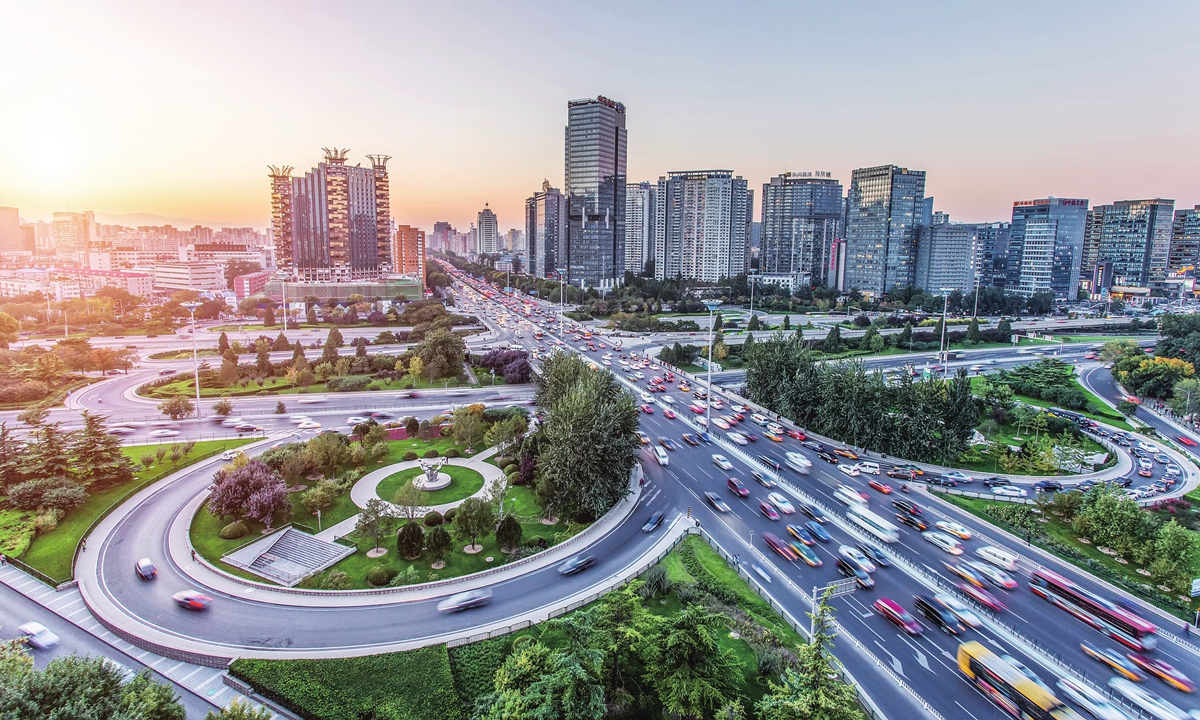China’s State Council urges laying solid foundation for 2023 economic growth, amid expectation for rapid recovery

A view of Beijing Photo: VCG
Chinese Premier Li Keqiang presided over a State Council executive meeting on Tuesday, stressing the need to better coordinate epidemic prevention and control and economic and social development to lay a solid foundation for growth in 2023, following the country's adoption of optimized epidemic prevention and control measures.
The latest call for efforts to boost growth in 2023 comes as expectations both in China and abroad are growing for a rapid recovery in the world's second-largest economy next year, with many domestic and foreign institutions expecting a growth rate of around 5 percent in 2023, pointing to the lifting of anti-epidemic restrictions and various efforts to stabilize growth.
The State Council executive meeting said that in the near future, relevant government departments should once again supervise local governments to implement a package of policies and measures to stabilize the economy and shoulder the responsibility of stabilizing growth, according to the China Media Group (CMG) on Wednesday.
The meeting also called for efforts to strengthen measures to ensure supply and stabilize the prices of key commodities to meet the needs of the people and effectively guarantee the needs of the public for epidemic prevention materials and medicine, strengthen international cooperation, and import urgently needed supplies reasonably, CMG reported.
The State Council's call for boosting growth in 2023 comes as optimism grows over an uptrend in China's economy, with growing calls from both at home and abroad for buoyant prospects in 2023, despite global gloom.
Lu Ting, chief China economist at Nomura said that "we raised our 2023 annual GDP growth forecast from 4 percent to 4.8 percent," citing the country's faster-than-expected pace toward an optimized response to the coronavirus, according to Nomura's 2023 outlook for key economies sent to the Global Times on Wednesday.
The upward revision stood in stark contrast to downtrends elsewhere. "A growth recession is likely in South Korea and Australia," read the Nomura outlook, quoting Sonal Varma, Nomura's chief economist for India and Asia excluding Japan. On average, GDP growth in Asia excluding Japan was forecast to slow to 3.1 percent next year, from 4 percent in 2022.
In another sign of optimism, Jonathan Garner, chief Asia and EM strategist at Morgan Stanley, said on Bloomberg TV on Tuesday that "expectations for growth in China are moving up really quite aggressively, so we've just raised our China GDP growth forecast for next year to 5.4 percent."
"If we're right, the Chinese economy next year would be growing 10 times as fast as the US economy," Garner said.
China's economic growth will likely hit 5 percent or even higher next year, Kristina Hooper, chief global market strategist at US asset management firm Invesco, told reporters during a teleconference earlier in December. Inflation is not a concern in China and the country's central bank is expected to maintain a supportive monetary policy, according to Hooper.
Likewise, Chinese brokers and think-tanks give a higher rating for Chinese economic growth in 2023.
The Chinese Academy of Social Sciences predicted China's economy to expand by 5.1 percent in 2023, citing growth drivers of the new economy including smart manufacturing, green and low-carbon industries, improved epidemic prevention and control measures, and a low base effect this year, according to a blue paper released last week.
Ming Ming, chief economist at CITIC Securities, expected the Chinese economy to grow by around 5 percent in 2023, as marginal changes in measures to stabilize growth and epidemic prevention and control are expected to boost an economic recovery in the first half of next year.
There should be two economic growth peaks in the second and fourth quarters, Ming said, expecting the nation's fiscal policy next year to be more active and monetary policy to maintain a loose tone.
Estimating that the economy would rise by 3.5 percent throughout an eventful 2022, Dong Ximiao, chief researcher of China's Qinnong Bank, told the Global Times on Wednesday that the economic growth target should be ideally set at above 5.5 percent for next year to effectively mobilize all parties into revving up growth.
The sanguine outlook goes against the World Bank's downward revision to its China forecasts, as the US-based institution announced a downward revision to its China growth prediction on Tuesday.
"Despite policy support, real GDP growth is expected to slow to 2.7 percent in 2022, before recovering to 4.3 percent in 2023," the World Bank said in its latest China Economic Update.
That suggests slight cuts to its October forecast when the World Bank put China's GDP growth at 2.8 percent this year before picking up to 4.5 percent in 2023.
Even at an annualized rate of 4.3 percent, the Chinese economy would see an addition of 7-8 trillion yuan ($1 trillion-$1.15 trillion) next year, which is "completely acceptable," Tian Yun, a veteran economist, told the Global Times on Wednesday.
The impact of policy divergence between China and the West, as well as shrinking global demand caused by US interest rate hikes, could emerge in the first half of 2023, Tian said.
"I don't think we need any additional policy stimulus to reach that level. We just need to get our lives, work and consumption back to normal," he continued.
According to Tian, the potential for economic growth next year mainly lies in the recovery of the suppressed demand of consumption, which is poised to boost economic growth by 2-3 trillion yuan when restored to its normal level.


